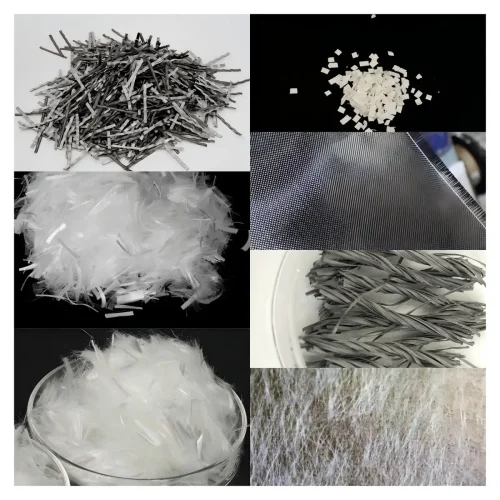
Concrete fiber has become a critical component in modern construction, significantly enhancing the durability, strength, and overall performance of concrete structures. Whether you’re involved in commercial, residential, or infrastructure projects, understanding the types of concrete fibers available and their specific applications is essential for achieving optimal results.
This article explores the top 7 types of concrete fiber, their properties, benefits, and ideal use cases, helping you choose the perfect fiber solution for your next project.
1. Macro Polypropylene (Macro PP) Fiber
Macro polypropylene fibers, also known as macro PP fibers, are synthetic fibers specifically designed to reinforce concrete structurally. They offer exceptional strength and crack resistance by creating a three-dimensional reinforcement network within the concrete.
Key Advantages:
- Excellent crack and shrinkage control
- Enhanced impact resistance
- Non-corrosive, ideal for harsh environments
- Cost-effective in long-term maintenance
Typical Applications:
- Industrial floors
- Pavements
- Airport runways
- Precast concrete structures
2. Micro Polypropylene Fiber
Micro polypropylene fibers are smaller than macro fibers and primarily address early-age cracking caused by plastic shrinkage. These fibers enhance the concrete surface quality and provide supplementary support to the concrete mixture.
Key Advantages:
- Reduces plastic shrinkage cracking
- Improves surface durability
- Enhances fire resistance
Typical Applications:
- Stucco and plaster mixes
- Residential flooring
- Thin-wall precast products
3. Steel Fiber
Steel fibers are known for significantly boosting concrete’s structural performance, including enhanced toughness, impact resistance, and post-crack performance. These fibers are typically produced in various shapes such as hooked-end, crimped, and straight.
Key Advantages:
- Significant structural reinforcement
- High impact and fatigue resistance
- Long-term durability
Typical Applications:
- Heavy-duty industrial flooring
- Bridge decks
- Tunnel linings
- Blast-resistant structures

4. Glass Fiber
Glass fibers are commonly used in architectural applications, providing excellent tensile strength and corrosion resistance. They are frequently incorporated into decorative concrete elements due to their lightweight properties and ease of use.
Key Advantages:
- High tensile strength
- Corrosion-resistant
- Lightweight and easy to handle
Typical Applications:
- Decorative panels
- Facade elements
- Thin architectural precast
- Glass fiber-reinforced concrete (GFRC)
5. Nylon Fiber
Nylon fibers provide excellent toughness and energy absorption, particularly in impact and abrasion resistance scenarios. They are used effectively in projects that require concrete with enhanced wear resistance.
Key Advantages:
- Exceptional impact and abrasion resistance
- Increased durability
- Enhanced fatigue performance
Typical Applications:
- Warehouses and industrial floors
- Loading docks
- High-traffic areas
- Mining and tunneling applications

6. Carbon Fiber
Carbon fibers represent high-end reinforcement options due to their superior tensile strength and stiffness. They are typically used in advanced structural applications and rehabilitation projects, significantly enhancing the structural integrity of existing concrete structures.
Key Advantages:
- Superior tensile strength
- Lightweight reinforcement
- Corrosion-resistant
- Ideal for structural retrofitting
Typical Applications:
- Structural strengthening
- Bridge repair
- High-performance structural applications
- Seismic retrofit projects
7. Cellulose Fiber
Cellulose fibers are derived from natural wood pulp and offer unique benefits in enhancing the rheological properties of concrete mixtures. They improve the concrete’s ability to hold water, enhancing workability and reducing cracking.
Key Advantages:
- Improved water retention
- Increased mix cohesiveness
- Environmentally friendly and sustainable
Typical Applications:
- Spray-applied concrete (shotcrete)
- Plastering and mortar mixes
- Repair mortars
- Sustainable construction projects

Selecting the Right Concrete Fiber
Choosing the right concrete fiber type involves evaluating several factors, including project requirements, environmental conditions, budget considerations, and the specific performance characteristics needed.
Important Considerations:
- Performance Requirements: Understand the structural and durability needs of your project.
- Environmental Conditions: Select fibers resistant to environmental stresses such as corrosion, moisture, and extreme temperatures.
- Cost-Efficiency: Balance initial investment with long-term benefits and reduced maintenance costs.
- Compatibility: Ensure compatibility of fiber type with your concrete mixture and construction method.
Часто задаваемые вопросы (FAQ)
Q: Can fibers replace traditional steel rebar in concrete?
A: While fibers enhance concrete significantly, they typically complement rather than fully replace traditional reinforcement methods, particularly in structural applications.
Q: Does adding fibers make concrete harder to work with?
A: Fibers can slightly alter the concrete’s consistency, but proper mix adjustments and good construction practices minimize any workability issues.
Q: Are concrete fibers environmentally friendly?
A: Some fibers, such as cellulose and polypropylene, offer sustainable benefits and help reduce environmental impact due to their long lifespan and reduced maintenance needs.
Заключение
Concrete fibers offer numerous advantages, from improved crack resistance and durability to enhanced structural performance and reduced maintenance costs. By selecting the appropriate fiber type, construction professionals can significantly boost the quality and sustainability of their projects.
For guidance on selecting and sourcing the ideal concrete fibers for your next project, contact our expert team today. We’re here to help you achieve exceptional construction outcomes.



